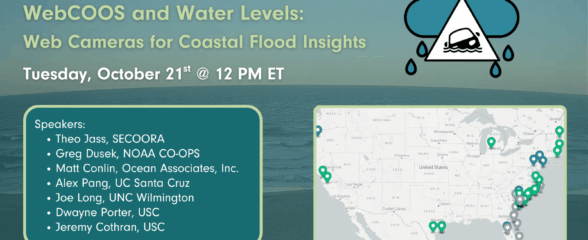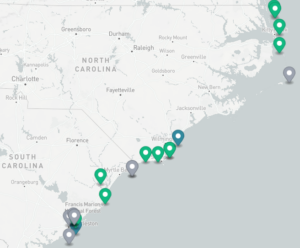On December 17th, a low pressure system developed in the Gulf of Mexico and traveled Northeast across the Florida peninsula to the Atlantic coast. The storm continued to strengthen as it approached the Carolinas, bringing coastal flooding, dangerous marine conditions, flash flooding, and strong wind gusts. Meteorologists call this type of storm a Nor’easter, which is a term used to categorize winter storms that develop in the Southeast with a Northeast trajectory. These storms typically occur between September and April, and can cause extensive damage.
SECOORA and its partners (including University of South Carolina, University of North Carolina Wilmington, University of California Santa Cruz, NOAA CO-OPS, USGS, and USACE) operate the Webcam Coastal Observation System (WebCOOS) with funding from NOAA. WebCOOS streamlines collection, storage, and access of coastal webcam imagery, and enables image analysis and development of products that can be used for decision making, including products related to shoreline change, rip currents, beach usage, and flood monitoring. WebCOOS cameras are primarily located in the SECOORA region, from Florida to North Carolina. The project team is working in partnership with the other IOOS Regional Associations to scale WebCOOS into a national system.
South Carolina
The storm caused major coastal flooding along the South Carolina coast, breaking records for highest non-tropical high tide. The Charleston Harbor Tide Gauge recorded 9.86 ft, which is the fourth highest tide on record right behind data collected during Hurricane Hugo. Additionally, rainfall records in downtown Charleston were broken, exceeding the previous record for this day by 2.68 inches. Check out the below video to see flooding impacts that occurred during this powerful storm in Charleston.
North Carolina
The North Carolina coast saw excessive rainfall, flooding, and extreme high tides. The Wilmington National Weather Service Forecast Office recorded 3.23 inches of rain on December 17th, which exceeds the previous record rainfall for that day by 2.35 inches. Preliminary data shows that high tide measurements peaked at 7 ft during the storm. Check out the below video of the extreme tides at Oak Island that occurred during the storm.
Using WebCOOS
WebCOOS is a great tool for monitoring weather events across the Southeast in real time. To check out all of the camera locations that are live-streaming in real time, visit the WebCOOS website.
Related news

SECOORA Webinar | WebCOOS and Water Levels: Web Cameras for Coastal Flood Insights
On October 21st at 12 PM ET, SECOORA is hosting a webinar with investigators from the Webcam Coastal Observation System (WebCOOS) project team and the WebCOOS Project Manager. Web cameras are a low-cost technology that can be used to document flooding impacts to coastal communities. Register here.

SECOORA Funding Opportunity Announcement: Letters of Intent Solicitation
SECOORA will submit a coordinated regional proposal in response to the anticipated FY 2026 Implementation of the U.S. Integrated Ocean Observing System (IOOS) funding opportunity. Letters of Intent to be considered for inclusion in SECOORA’s full proposal are due September 9, 2025.

SECOORA Hosts the First Surface Elevation Table (SET) Community of Practice Virtual Workshop
The SECOORA SET Workshop was virtual on July 17, 2025. More than 50 Community of Practice members and stakeholders joined this collaborative workshop to discuss SET monitoring, coastal resilience, and data-driven decision making in the Southeast.

